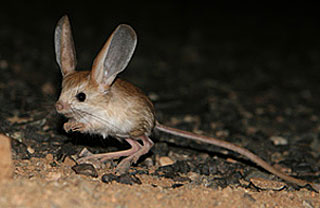Jerboas – Long-legged, hopping desert rodents

Jerboas live in deserts, semi-arid zones and steppe country in North Africa and Asia, where they construct complex burrow systems. Like desert kangaroo rats, they jump along on their back legs instead of running on all fours. Their legs are more than four times larger in back than in front, allowing them to jump 10 ft (3 m). That is quite impressive because the body is only 3.5 – 6 inches (15 – 19 cm) long but the long tail can add another 7 in (20 cm) to its length. Some species can stand upright on their long legs with the help of their large tail. Some species have very long ears. Being nocturnal, many also have eyes that are big relative to other daytime rodents so that they can see well at night.
The northern three-toed jerboa feeds on plants, seeds and insects. It needs very little water and is able to survive on the water contained in its food. In summer, it spends its days in a shallow burrow and emerges in the evening to travel to its feeding grounds, leaping along on its powerful hind limbs in autumn, it digs a deeper burrow and hibernates from November to March. Jerboas mate soon after awakening and may have two litters of 2 to 5 young in a season.

The great jerboa, like 10 of 11 species within their group (genus) of hopping desert rodents, has five toes on its long back feet. However, the great jerboa distinguishes itself by having some of the longest ears of its kind although the four-toed jerboa of Egypt and Libya and the long-eared jerboa of China and Mongolia (see pictures above) also compete for the long-eared crown. The great jerboas eat insects and seeds, which they find by raking the sand with the elongated claws on their front feet. They spend the daytime in burrows, sealing off the entrance to the burrow for the day to help keep cool.
There are quite a few other jerboas, about 31 species, with varying ear sizes. They are divided up into different groups based mostly on their geographic location or physical characteristics like number of toes and type of tail. These include pygmy jerboas (one from Baluchistan), three-toed jerboas, dwarf fat-tails and Iranian vegetarian jerboas.
